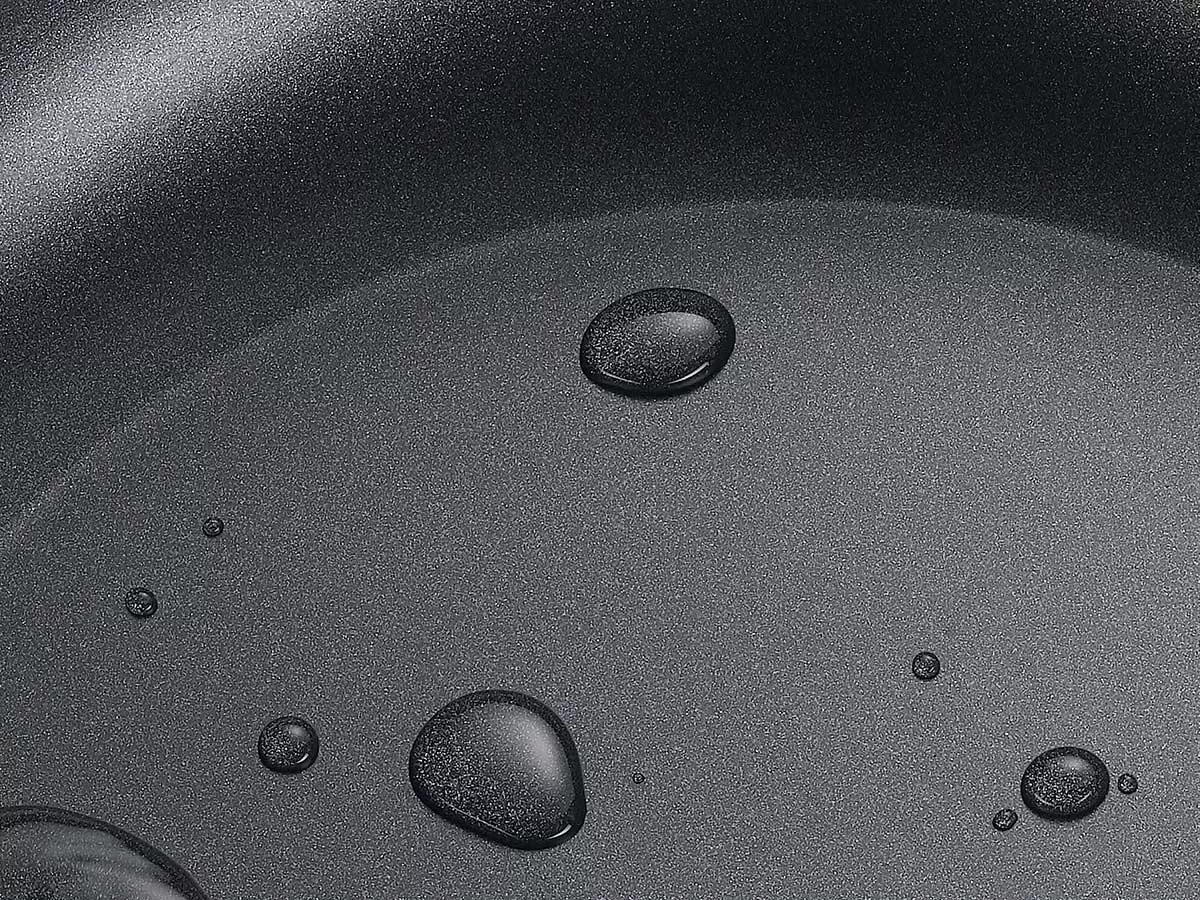Technological Advancements in Non-Stick Coatings
Introduction of Nanotechnology
Recent advancements in non-stick coatings have been significantly influenced by nanotechnology. This technology allows for the creation of coatings that are not only more effective but also safer for consumers. By using tiny particles, manufacturers can enhance the properties of coatings, making them more durable and resistant to wear.
Development of Sol-Gel Coatings
Another exciting development is the sol-gel coatings. These coatings are made through a process that transforms a liquid solution into a solid gel. This method provides a strong bond to surfaces, ensuring that the non-stick properties last longer. Sol-gel coatings are also known for their ability to withstand high temperatures, making them ideal for various cooking applications.
Enhanced Durability and Temperature Resistance
The latest non-stick coatings are designed to offer greater durability and temperature resistance. This means they can handle higher cooking temperatures without breaking down or releasing harmful substances. For instance, many modern coatings can withstand temperatures up to 500°F, which is a significant improvement over older versions.
| Coating Type | Max Temperature (°F) | Durability Rating |
|---|---|---|
| Traditional PTFE | 400 | Moderate |
| Sol-Gel | 500 | High |
| Nanotechnology-Based | 550 | Very High |
The introduction of graphene materials in non-stick coatings is a game changer, enhancing properties like abrasion resistance and antibacterial features, making them safer and more effective for everyday use.
In summary, the non-stick coatings market is evolving rapidly, driven by innovations that focus on safety, durability, and performance. These advancements not only improve the user experience but also address health concerns associated with traditional non-stick materials.
Regulatory Challenges in the Non-Stick Coatings Market
Impact of Environmental Regulations
The non-stick coatings market faces significant hurdles due to strict environmental regulations. Many countries have implemented laws to limit harmful chemicals in these products. For example, some states in the U.S. have banned PFAS in cookware, which affects manufacturers and consumers alike.
Safety Concerns and Consumer Perception
Consumer safety is a major concern. Many people worry about the safety of non-stick coatings. This has led to a decline in trust, making it essential for companies to prove their products are safe. Manufacturers must invest in research to ensure their coatings meet safety standards and address public fears.
Compliance with International Standards
To sell non-stick coatings globally, companies must comply with various international standards. This can be a complex process, as regulations differ from one country to another. Companies need to stay updated on these rules to avoid penalties and ensure their products can be marketed worldwide.
The evolving landscape of regulations means that manufacturers must adapt quickly to remain competitive in the non-stick coatings market.
| Regulation Type | Description | Impact |
|---|---|---|
| Environmental | Limits on harmful chemicals | Affects product formulation |
| Safety | Standards for consumer safety | Increases production costs |
| International | Compliance with global standards | Complicates market entry |
- Key Points:
- Regulations vary by region.
- Companies must invest in compliance.
- Consumer trust is crucial for market success.
Market Segmentation and Key Applications
Cookware and Bakeware
The cookware and bakeware segment is one of the largest in the non-stick coatings market. Non-stick coatings make cooking easier and healthier by reducing the need for oil. This segment is expected to grow significantly due to rising consumer demand for easy-to-clean kitchenware.
Industrial Applications
In industrial settings, non-stick coatings are used in various machinery and equipment. These coatings help in reducing friction and wear, which can lead to longer-lasting equipment. Industries like automotive and aerospace are major users of these coatings, benefiting from their chemical resistance and durability.
Medical and Food Processing Sectors
Non-stick coatings are also crucial in the medical and food processing sectors. In medical applications, they are used for surgical instruments and devices, ensuring easy cleaning and preventing contamination. In food processing, these coatings help in maintaining hygiene and efficiency during production.
| Application | Market Size (USD) | Growth Rate (%) |
|---|---|---|
| Cookware and Bakeware | 1.2 billion | 6.81 |
| Industrial Applications | 800 million | 5.5 |
| Medical Sector | 500 million | 4.2 |
| Food Processing | 600 million | 5.0 |
Non-stick coatings are essential in various industries, providing benefits like easy cleaning and enhanced performance. Understanding these applications helps stakeholders make informed decisions in the market.
Regional Analysis of the Non-Stick Coatings Market
Growth in Asia-Pacific
The Asia-Pacific region is expected to lead the global non-stick coatings market. This growth is driven by a large number of manufacturers and sellers of non-stick cookware. The increasing population is a major factor contributing to the demand for effective cookware. Additionally, rising incomes and a growing middle class are enhancing the quality of life, which further boosts market growth.
Market Trends in North America
In North America, the non-stick coatings market is also expanding. Consumers are becoming more health-conscious, leading to a demand for safer and more durable non-stick products. The market is projected to grow steadily, with a focus on innovative coating technologies that meet safety standards.
Emerging Markets in Europe and Latin America
Europe and Latin America are witnessing emerging trends in the non-stick coatings market. In Europe, there is a strong emphasis on environmental regulations and safety concerns, which are shaping consumer preferences. Meanwhile, Latin America is experiencing growth due to increasing urbanization and a rising middle class, leading to higher demand for non-stick cookware.
| Region | Market Size (2022) | Projected Growth Rate (CAGR) | 2024-2032 Forecast |
|---|---|---|---|
| Asia-Pacific | USD 1.74 Billion | 5.1% | USD 2.65 Billion |
| North America | USD 0.5 Billion | 4.5% | USD 0.7 Billion |
| Europe | USD 0.4 Billion | 4.0% | USD 0.6 Billion |
| Latin America | USD 0.2 Billion | 3.5% | USD 0.3 Billion |
The non-stick coatings market is poised for significant growth, especially in the Asia-Pacific region, where demand is driven by a growing population and rising incomes.
This regional analysis highlights the diverse factors influencing the non-stick coatings market across different areas, showcasing both opportunities and challenges for manufacturers and consumers alike.
Growth Drivers and Opportunities
Rising Health-Conscious Consumer Segment
The non-stick coatings market is booming as more people are becoming health-conscious. Non-stick cookware allows for cooking with less oil, making it easier to prepare healthier meals. This shift in consumer behavior is driving demand for non-stick products, especially in cookware and bakeware.
Increasing Number of Market Players
The number of companies entering the non-stick coatings market is on the rise. Established brands are innovating to keep up with changing consumer preferences. For example, TTK Prestige launched a new product called Durastone, which features multiple layers of non-stick coating. This competition is beneficial for consumers, as it leads to more choices and better products.
Innovations in Coating Technologies
New technologies in non-stick coatings are creating exciting opportunities. These advancements not only improve the performance of the coatings but also make them safer and more durable. As companies invest in research and development, we can expect to see even more innovative products in the market.
The non-stick coatings industry is experiencing significant growth, with a market value projected to rise from USD 1,475.42 million in 2022 to USD 2,720.47 million by 2031, reflecting a CAGR of 7.2%. This growth is driven by the increasing demand for durable and easy-to-clean cookware, promoting healthier cooking and convenience.
Challenges and Restraints
Health and Safety Concerns
The use of non-stick coatings has raised serious health concerns among consumers. Many worry about the potential risks associated with chemicals used in these coatings, especially fluoropolymers. Research indicates that some of these substances can release harmful fumes when overheated, leading to health issues.
Market Competition and Pricing Pressure
The non-stick coatings market is highly competitive, with numerous players vying for market share. This competition often leads to pricing pressure, making it difficult for companies to maintain profit margins. As new entrants emerge, established brands must innovate to stay relevant.
Supply Chain Disruptions
Recent global events have highlighted vulnerabilities in supply chains. Disruptions can affect the availability of raw materials needed for non-stick coatings, leading to delays and increased costs. Companies must adapt to these challenges to ensure consistent production.
The non-stick coatings market faces significant hurdles, but addressing these challenges can lead to innovative solutions and safer products.
| Challenge | Impact on Market |
|---|---|
| Health and Safety Concerns | Decreased consumer trust |
| Market Competition | Lower profit margins |
| Supply Chain Disruptions | Increased production costs |
Future Outlook and Market Forecast
Projected Market Growth
The global non-stick coatings market is expected to grow significantly in the coming years. By 2030, the market size is projected to reach approximately USD 2.65 billion, up from around USD 1.74 billion in 2022. This growth represents a compound annual growth rate (CAGR) of about 5.39% from 2023 to 2030.
Potential for New Entrants
As the market expands, there will be opportunities for new companies to enter. Factors driving this include:
- Rising health-conscious consumers looking for safer cooking options.
- Innovations in coating technologies that enhance performance and safety.
- Increased demand for non-stick cookware and industrial applications.
Long-Term Industry Trends
The non-stick coatings market is likely to see several long-term trends, including:
- Maturation in non-stick coatings manufacturing process, which improves product quality and durability.
- A focus on sustainability and eco-friendly materials in response to consumer demand.
- Ongoing advancements in nanotechnology and sol-gel coatings that enhance performance.
The future of the non-stick coatings market looks promising, with numerous opportunities for growth and innovation. Companies that adapt to changing consumer preferences and regulatory requirements will likely thrive in this evolving landscape.
Conclusion
In summary, the non-stick coatings market is evolving rapidly, driven by new technologies and changing consumer preferences. As more people become health-conscious, the demand for safer and more efficient non-stick cookware is on the rise. Innovations like nanotechnology are making these coatings even better, offering features such as higher durability and resistance to scratches. However, challenges like strict regulations and safety concerns still exist. Despite these hurdles, the future looks bright for this market, especially in regions like Asia-Pacific, where the demand for non-stick products continues to grow. Overall, the non-stick coatings market is poised for significant growth, making it an exciting area to watch.









